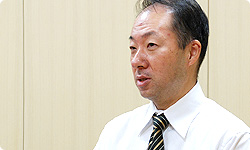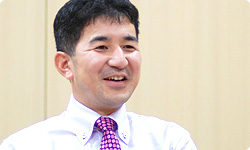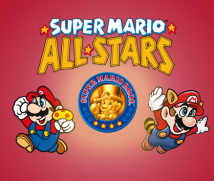5. Music Commentary by Koji Kondo (2)
I have a story involving the Athletic Theme for Super Mario Bros. 3. Mind if I talk about it?
Go ahead.
I tried playing this on the piano as a child, but I couldn’t do it. After ♪doo-da-da doo-da-da doo-da doo-da-da, it goes ♪dweee!
It’s a portamento.
Right. A portamento. An unbroken slide from one pitch to another is called a portamento. I couldn’t do that on a piano.
It’s not fit for playing on a piano.
I couldn’t play that dweee sound, so I grew up to be an adult with that song only 90% complete inside me.
(laughs)
But I really liked this song, so I thought I’d use it in Super Mario Galaxy. There was an athletic level just right for it, so I did a nice arrangement including the dweee sound and finally took care of that song.
After many years, you finally achieved your destiny.
Yeah. I finally graduated! (laughs)
Next is the Ground Theme for Super Mario World. Reflecting back on how I had put so many different songs into Super Mario Bros. 3, I decided to use the same themes - like “above ground” or “underground” - in different arrangements for the various levels. If I did that, I thought the music would change scene by scene, but the melodies would be the same, so they would stick with the game’s listeners.
The trouble you had with Super Mario Bros. 3 determined how you composed the music for later Mario games.
Super Mario World was for the Super Famicom (Super NES), so I was overjoyed at being able to make eight sounds all at once. In order to convey to players just how great the Super Famicom was, I decided to use a bunch of instruments at once, using them one right after the other in the title song.

To tell the players how the Super Famicom could make all kinds of different sounds.
Right. (laughs) But I was worried about something. The square waves and triangle waves in game music up to that point had gained acceptance.
People called it the beep-beep sound.
That electronic sound had established itself apart from other music, and I myself had thought of that as game music, but with the Super Famicom, I could use all kinds of instruments and make all kinds of music, so I started worrying about what exactly game music was. While working on Super Mario World, I decided that game music should be music that uses an ensemble of instruments that you wouldn’t usually hear anywhere else.
Hmm…
Ahh, I see…
There might be a bugle together with a banjo, for example.
Combinations you wouldn’t usually hear.
Unusual combinations of instruments… But I do suppose you are consistent about trying to present unique music every time.
I look like I’m not thinking much, but I really am. (laughs)
(laughs)
For sound effects as well, I could have used square waves as up to that point, but since I had better sound now, I decided to leave the mode as it was for sound effects and use the timbre of musical instruments. For example, the sound for jumping is a pan flute.
You used a pan flute sound and changed it to sound like a video game sound effect.
Yes.
So it’s the traditional game technology with new timbres - a hybrid with new materials.
That’s how I made the sound for Super Mario World.
The N64 had 3D modelling capabilities, so I had to drastically change the soundscape. I didn’t think I could make the music the same way that I had before. The N64 had even better sound capabilities. I could create sound almost like you would hear on a regular music CD. There were some complications making the data, but bass was bass and drums were drums. Making the music was like actually playing real instruments.
Mario 64 was when Mario first started making sounds with his voice.
Right. It was decided that we should give him a voice. In 3D, I couldn’t get the jump sound I used so far to match the action right. So I put in a sound for when he lifted off and for when he landed, and I had him make a sound with his voice. A lot changed starting with the N64, including how I viewed sound effects.
Next is “Delfino Plaza” from Super Mario Sunshine.14 The sound source improved even further with the Nintendo GameCube. It could generate a pretty crisp guitar sound, so I decided to make good use of that. And the game takes place on a southern island, but the other developers told me the resort area was more European than Latin American or Pacific in character, so I decided to make music to suit that kind of atmosphere. 14Super Mario Sunshine: A 3D action game released for the Nintendo GameCube system in July 2002 in Japan.
Kondo-san, I hate to interrupt, but do you mind if I give my evaluation of the music for Delfino Plaza?
No, go ahead.
I gave it full marks!
Oh! (laughs)
When Super Mario Sunshine came out, I had started working on game music at a different company. I called the people around me over and said, “This is what game music scoring 100/100 sounds like, so listen!” I stressed to them how the music was able to concentrate everything from the general atmosphere of the game world to the fun of spraying water using just a few sounds.

I see you’re the type who just can’t rest until you share songs that you like with other people! (laughs)
(laughs)
Well, that’s how much I thought the music for Delfino Plaza contained the game world. I always wanted to tell Kondo-san that sometime.
Thank you!
But I wanted to say it, not as a company employee, but as a fan of video game music.
You’re not just buttering him up. (laughs)
No, no! (laughs)
Next is the Main Theme for New Super Mario Bros.15 on the Nintendo DS. Actually, someone else was in charge of making this song, but someone told me it didn’t quite sound like Mario music, so I decided to redo it. 15 New Super Mario Bros.: An action game released for the Nintendo DS in May 2006 in Japan.
To be honest, when I first heard that song, I thought it sounded like someone trying to copy the feeling of the traditional Mario music. But you were the one who made this song.
That’s right. New Super Mario Bros. is a side-scroller just like the older games, but the characters are in 3D and the game console is handheld, so I wondered how I could change the music, and I fretted over it even as I finished it up…
Were you worried because while it was a traditional side-scrolling Mario game, you also had to make it feel new?
Right. I really fretted over how I could change it from previous music. The other songs were made by other staff members, but the music feels new and we managed to generate a pretty nice sound quality through the Nintendo DS system’s small speakers, so I feel like overall it came together pretty well.
